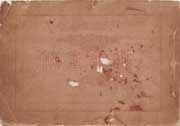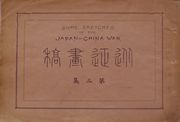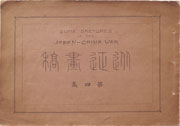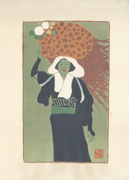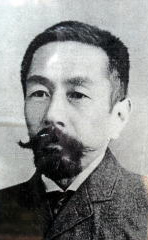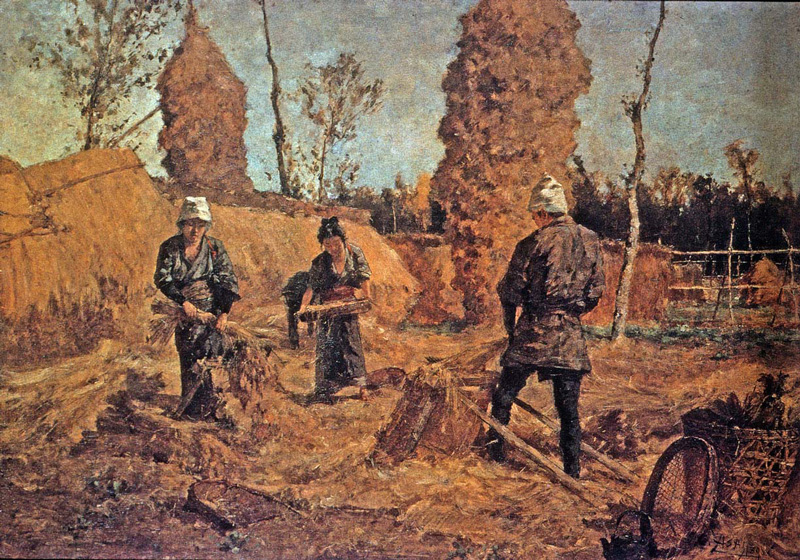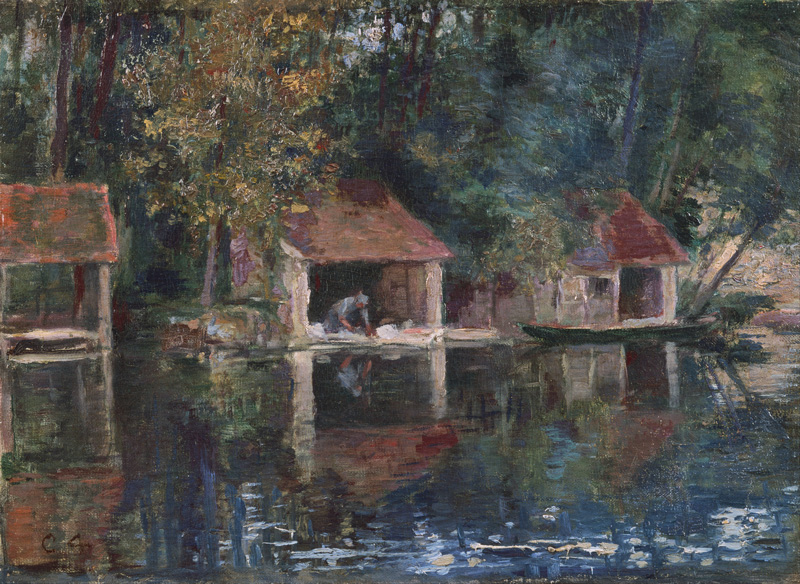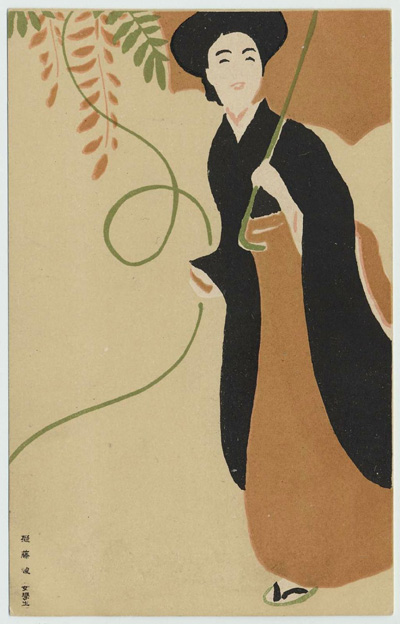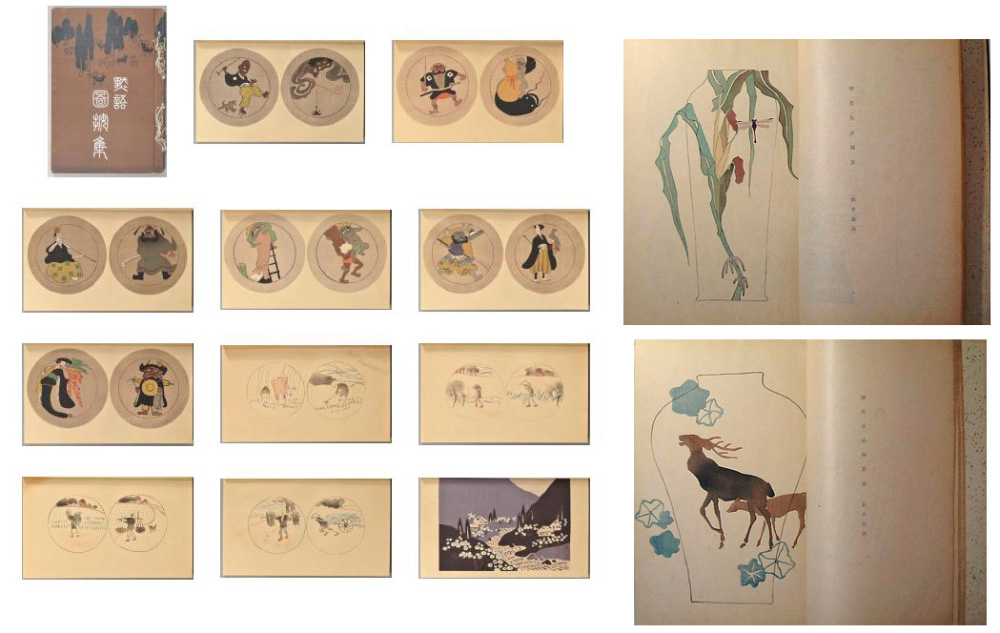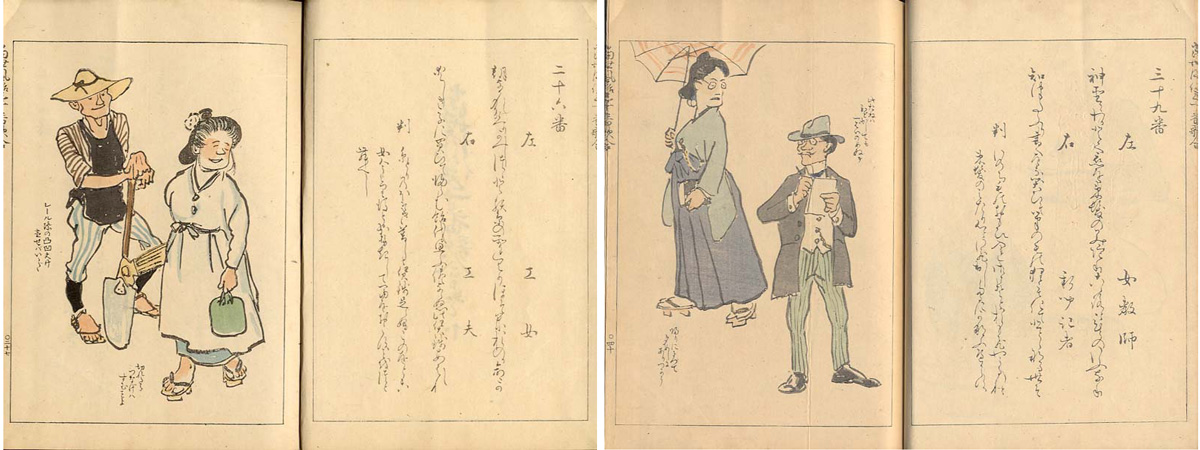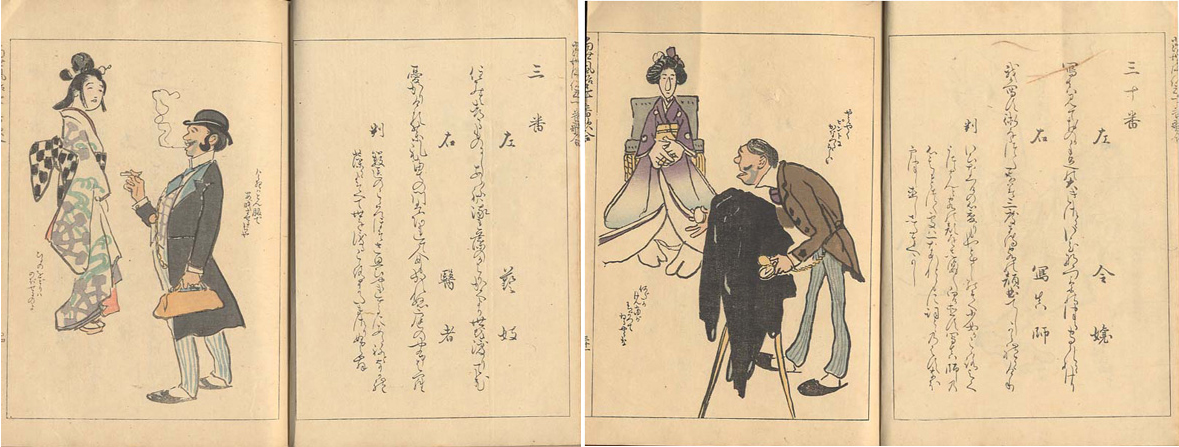Prints in Collection
| Some Sketches of the Japan-China War, Volume 1, 1895 IHL Cat. #871 | Some Sketches of the Japan-China War, Volume 3, 1895 IHL Cat. #872 | Some Sketches of the Japan-China War, Volume 4, 1895 IHL Cat. #873 |
Kyōto no maki, 1911
IHL Cat. #2398a
Biographical Data
In Sakura, Chū attended a school where his father was the principal. He was formally trained in traditional Japanese bird-and-flower painting (kachoga) by the Sakura fief teacher Kurosawa Kaizan3, but later turned to oil painting as he embraced Western-style art.
In 1873 he moved to Tokyo to study English and in 1875, at the age of 19, became a student of the Western-style painter Shinkurō Kunisawa (1847-1877) at his private art school, Shōgido. Shinkurō introduced him to the Italian painter Antonio Fontanesi (1818-1882), who had been brought to Japan by the Meiji government to introduce European oil painting, and he enrolled in the Ministry of Industry's, Kobu Bijutsu Gakko (Technical Fine Arts School)4, to study with Fontanesi.5
From Fontanesi "Asai acquired the Barbizon School’s empathic view of people and natural beauty. After Fontanesi returned to Italy, just as Western-style painting was beginning to develop in Japan, Asai developed his own style, producing lyrical landscapes portraying fishing and farming villages in a palette of greens and browns"6 associated with the Barbizan school, although after his two year stay in Paris he was to turn to a brighter palette. (See comparison between the 1890 and 1901 paintings shown below.)
After the departure of Fontanesi in 1878, Asai left the Kobu Bijutsu Gakko and formed the Jūichi-kai and in 1889 helped organize the Meiji Bijutsukai (Meiji Fine Art Society), the first group of Western-style painters in Japan.7
In October 1893, Asai married Naoshi Yasuko from a former Sakura clan.8
In 1894 he was dispatched to China as a media correspondent by the Japanese newspaper Jiji shipō to illustrate engagements in the Sino-Japanese War. The sketches he created there were transformed later that year into lithographs in the 4 volumes of Some Sketches of the Japan-China War, published by Shinyōdō. (See IHL Cat. 871, 872, 873.) Upon his dispatch to the front Asai stated:
In 1895 he was commissioned by the Japanese Education Ministry, the Monbushō, to create a series of drawing textbooks teaching Western-style art.
In 1898 he was appointed professor at the Tokyo School of Fine Arts where he taught Western-style painting.
At the age of 44, in 1900, the Japanese government sent him to Paris to attend the Exposition Universelle in which his work and the work of other Japanese artists were featured. He stayed in France for two years, finding that even in middle-age he "had much to learn."10 In describing his Paris sojourn Asai commented that it filled him with "a new excitement and enthusiasm."11 He became fascinated by the then-current style of Art Nouveau and transmitted that style back to Japan.
While in France, he stayed in Grez-sur-Loing, a village southwest of Fontainebleau, to paint and sketch for several months. "In Grez he lightened his palette considerably and created a series of plein-air works that, when he returned to Japan, helped transmit a fresh wave of inspiration to younger Japanese painters."12
In 1902, after returning to Japan, he was appointed professor at the Kyoto Koto Kōgei Gakkō (the Kyoto School of Arts and Crafts), and founded the Kansai Bijutsu-in (the Kansai Arts Institute) and the Shōgoin Yōga Kenkyūsho. He also "opened an atelier in Kyoto for his monjin [students] and christened it the Yoga Kenkujo."13 His students included Yasui Sōtarō (1888-1955), Ryūzaburō Umehara (1888-1986), Suda Kunitarō (1891-1961), Ishii Hakutei (1882-1958), Tsuda Seifu (1880-1978) and Maekawa Senpan (1888-1960) among many others.
He formed the Yutoen group with young ceramic artists to promote ceramic design and with lacquerware artisans formed the Kyoshitsuen group, both embracing an "enthusiastic new design sensibility."14 During his later years in Kyoto "he was involved in industrial design projects reflecting his encounter with Art Nouveau in Paris."15
In the final year of his life in 1907, Asai became the judge for the first national Ministry of Education sponsored art exhibition. He also established the Kyundo to create ceramics from his original designs.16 "A teacher until his death, Asai was an important conduit for new ideas which enriched both oil painting and understanding of modern Western art in Japan."17
Many of Asai’s works are deemed to be important and the Agency For Cultural Affairs in Japan recognizes them as “Important Cultural Properties”.
While not a print-maker per se, a number of his designs have been turned into single-sheet woodblock prints or woodblock printed pages of books by the publisher Unsodo, such as the 12 print series of ōtsue designs used on ceramic plates (currently available from Unsodo and shown below) and the book Mokugo zuanshu, issued by Unsodo in 1908, devoted to his designs for applied arts (also shown below.)
In addition to the above, Asai designed original illustrations for books, some produced using woodblock such as A Poetry Contest on Contemporary Customs in Fifty Turns (Tōsei fūzoku gojūban utaawase), published in 1907 by Yoshikawa Hanshichi, four pages of which are shown below.
He taught prominent print-makers such as Ishii Hakutei and Maekawa Senpan and Hillier states that his influence "runs through both the Shin Hanga and Sosaku Hanga movements..." and "[a]s the master of such artists as Ishii Hakutei, Umeharu Ryūzaburō, Maekawa Sempan and Nakamura Fusetsu, Asai Chu must be seen as one of those 'bridging' artists between the traditional or nationalistic art and the cosmopolitan internationalism of Sosaku Hanga."18
1 The Art of the Japanese Book, Jack Hillier, Sothebys Publications, London, 1987, p. 997.
2 Modern Currents in Japanese Art, Michiaki Kawakita, Weatherhill/Heibonsha, 1974, p. 39.
3 Biographical Dictionary of Japanese Art, Yutaka Tazawa, Kodansha International, Ltd. in collaboration with the International Society for Educational Information, Inc., 1981, p. 52.
4 The school was a special section of the government college that had been set up under the Ministry of Industry. Two of its stated purposes was to foster the introduction of Western techniques into Japanese industry of all kinds and to "study the new realistic styles in order to make up for the short points of traditional art." [Modern Currents in Japanese Art, p. 38].
5 Fontanesi taught in Japan for 2 years until a lack of funds and facilities drove him back to Italy.
6 Bridgestone Museum website http://www.bridgestone-museum.gr.jp/en/collection/artist72/
7 Op. cit., Biographical Dictionary of Japanese Art
8 Mie Prefectural Art Museum http://www.bunka.pref.mie.lg.jp/art-museum/en/Collection/E_asai.htm
9 Society and the State in Interwar Japan, edited Elise K. Tipton, Taylor & Francis, 2012, p. 71.
10Paris in Japan: The Japanese Encounter with European Painting; Takashima, Rimer and Bolas, The Japan Foundation and Washington University, 1987, p. 98.
11 Ibid.
12 Ibid.
13 The International Studio, "The Modern Development of Oil Painting in Japan," Prof. Jiro Harada, John Lane Company, NY, March 1915, p. 277.
14 Bridgestone Museum website http://www.bridgestone-museum.gr.jp/en/collection/artist72/ Asai was responsible for a number of creative innovations in the decorative arts, especially in the techniques of maki-e (painting in gold and silver on lacquer).
["The Faraway Sources: Japan - A Fresh Look at Traditional Form," Hiroyasu Fujioka, appearing in The Unesco Courier, August 1990, p. 18-19.]
15 Ibid. While in Paris, Asai was invited by the collector and champion of the avant garde, Samuel Bing, to visit his Art Nouveau pavilion at the Exhibition. ["The Faraway Sources: Japan - A Fresh Look at Traditional Form," Hiroyasu Fujioka, appearing in The Unesco Courier, August 1990, p. 18-19.]
16 Kyoto Institue of Technology website http://www.kit.ac.jp/english/11/topics/2010/asai_chu100402.html
17 Op. cit., Paris in Japan, p. 98.
18 Op. cit., The Japanese Book, p. 997.
In Sakura, Chū attended a school where his father was the principal. He was formally trained in traditional Japanese bird-and-flower painting (kachoga) by the Sakura fief teacher Kurosawa Kaizan3, but later turned to oil painting as he embraced Western-style art.
In 1873 he moved to Tokyo to study English and in 1875, at the age of 19, became a student of the Western-style painter Shinkurō Kunisawa (1847-1877) at his private art school, Shōgido. Shinkurō introduced him to the Italian painter Antonio Fontanesi (1818-1882), who had been brought to Japan by the Meiji government to introduce European oil painting, and he enrolled in the Ministry of Industry's, Kobu Bijutsu Gakko (Technical Fine Arts School)4, to study with Fontanesi.5
From Fontanesi "Asai acquired the Barbizon School’s empathic view of people and natural beauty. After Fontanesi returned to Italy, just as Western-style painting was beginning to develop in Japan, Asai developed his own style, producing lyrical landscapes portraying fishing and farming villages in a palette of greens and browns"6 associated with the Barbizan school, although after his two year stay in Paris he was to turn to a brighter palette. (See comparison between the 1890 and 1901 paintings shown below.)
After the departure of Fontanesi in 1878, Asai left the Kobu Bijutsu Gakko and formed the Jūichi-kai and in 1889 helped organize the Meiji Bijutsukai (Meiji Fine Art Society), the first group of Western-style painters in Japan.7
In October 1893, Asai married Naoshi Yasuko from a former Sakura clan.8
In 1894 he was dispatched to China as a media correspondent by the Japanese newspaper Jiji shipō to illustrate engagements in the Sino-Japanese War. The sketches he created there were transformed later that year into lithographs in the 4 volumes of Some Sketches of the Japan-China War, published by Shinyōdō. (See IHL Cat. 871, 872, 873.) Upon his dispatch to the front Asai stated:
| On this occasion which occurs only rarely, [I] shall depict the real situation in the army and shall paint what words do not well attain, so as to compensate for the deficiencies in the historical record for later times.9 |
In 1895 he was commissioned by the Japanese Education Ministry, the Monbushō, to create a series of drawing textbooks teaching Western-style art.
In 1898 he was appointed professor at the Tokyo School of Fine Arts where he taught Western-style painting.
At the age of 44, in 1900, the Japanese government sent him to Paris to attend the Exposition Universelle in which his work and the work of other Japanese artists were featured. He stayed in France for two years, finding that even in middle-age he "had much to learn."10 In describing his Paris sojourn Asai commented that it filled him with "a new excitement and enthusiasm."11 He became fascinated by the then-current style of Art Nouveau and transmitted that style back to Japan.
While in France, he stayed in Grez-sur-Loing, a village southwest of Fontainebleau, to paint and sketch for several months. "In Grez he lightened his palette considerably and created a series of plein-air works that, when he returned to Japan, helped transmit a fresh wave of inspiration to younger Japanese painters."12
Harvest (収穫 Shukaku), 1890 oil on canvas (a darker Barbizon palette of browns and greens) | Washing Place in Grez-sur-Loing, 1901 Oil on canvas Bridgestone Museum of Art, Tokyo (a lighter palette inspired by the Impressionists) |
He formed the Yutoen group with young ceramic artists to promote ceramic design and with lacquerware artisans formed the Kyoshitsuen group, both embracing an "enthusiastic new design sensibility."14 During his later years in Kyoto "he was involved in industrial design projects reflecting his encounter with Art Nouveau in Paris."15
| Set of 10 Oribe ware mukozuke dishes with designs by Asai Chū and ceramic by Kiyomizu Rokubei V. | Female Student in a Parody of the Wisteria Maiden from the series Up-to-date Otsu-e, 1905 Gi Fuji musume (jogakusei) from the series Imayo Otsu-e 「擬藤娘(女学生)」 今様大津絵より Museum of Fine Arts, Boston Accession Number 2002.912 |
In the final year of his life in 1907, Asai became the judge for the first national Ministry of Education sponsored art exhibition. He also established the Kyundo to create ceramics from his original designs.16 "A teacher until his death, Asai was an important conduit for new ideas which enriched both oil painting and understanding of modern Western art in Japan."17
Many of Asai’s works are deemed to be important and the Agency For Cultural Affairs in Japan recognizes them as “Important Cultural Properties”.
While not a print-maker per se, a number of his designs have been turned into single-sheet woodblock prints or woodblock printed pages of books by the publisher Unsodo, such as the 12 print series of ōtsue designs used on ceramic plates (currently available from Unsodo and shown below) and the book Mokugo zuanshu, issued by Unsodo in 1908, devoted to his designs for applied arts (also shown below.)
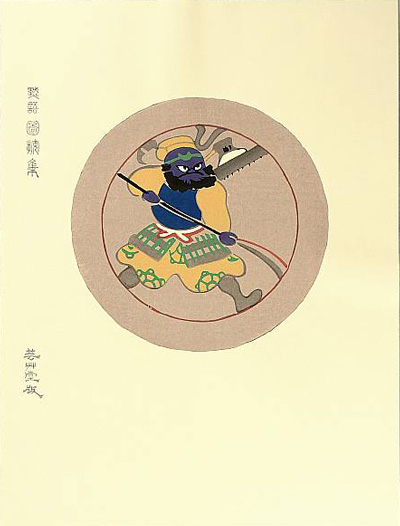 Benkei and his long sword from a series of 12 otsu-e woodblock prints by Unsodo Publishing | Mokugo zuanshu, 1908 by Unsodo Publishing Published posthumously by his friends devoted to his designs for applied arts in a style influenced by the Rimpa school, the folk paintings of Otsu and French Art Nouveau. 24 fine woodblock colour illustrations and 41 plates with many b/w photographs of original drawings, paintings, ceramics, lacquers, small sculptures and textiles. [as described in Catalog 12,issued by Morra Japanese Art] |
In addition to the above, Asai designed original illustrations for books, some produced using woodblock such as A Poetry Contest on Contemporary Customs in Fifty Turns (Tōsei fūzoku gojūban utaawase), published in 1907 by Yoshikawa Hanshichi, four pages of which are shown below.
He taught prominent print-makers such as Ishii Hakutei and Maekawa Senpan and Hillier states that his influence "runs through both the Shin Hanga and Sosaku Hanga movements..." and "[a]s the master of such artists as Ishii Hakutei, Umeharu Ryūzaburō, Maekawa Sempan and Nakamura Fusetsu, Asai Chu must be seen as one of those 'bridging' artists between the traditional or nationalistic art and the cosmopolitan internationalism of Sosaku Hanga."18
1 The Art of the Japanese Book, Jack Hillier, Sothebys Publications, London, 1987, p. 997.
2 Modern Currents in Japanese Art, Michiaki Kawakita, Weatherhill/Heibonsha, 1974, p. 39.
3 Biographical Dictionary of Japanese Art, Yutaka Tazawa, Kodansha International, Ltd. in collaboration with the International Society for Educational Information, Inc., 1981, p. 52.
4 The school was a special section of the government college that had been set up under the Ministry of Industry. Two of its stated purposes was to foster the introduction of Western techniques into Japanese industry of all kinds and to "study the new realistic styles in order to make up for the short points of traditional art." [Modern Currents in Japanese Art, p. 38].
5 Fontanesi taught in Japan for 2 years until a lack of funds and facilities drove him back to Italy.
6 Bridgestone Museum website http://www.bridgestone-museum.gr.jp/en/collection/artist72/
7 Op. cit., Biographical Dictionary of Japanese Art
8 Mie Prefectural Art Museum http://www.bunka.pref.mie.lg.jp/art-museum/en/Collection/E_asai.htm
9 Society and the State in Interwar Japan, edited Elise K. Tipton, Taylor & Francis, 2012, p. 71.
10Paris in Japan: The Japanese Encounter with European Painting; Takashima, Rimer and Bolas, The Japan Foundation and Washington University, 1987, p. 98.
11 Ibid.
12 Ibid.
13 The International Studio, "The Modern Development of Oil Painting in Japan," Prof. Jiro Harada, John Lane Company, NY, March 1915, p. 277.
14 Bridgestone Museum website http://www.bridgestone-museum.gr.jp/en/collection/artist72/ Asai was responsible for a number of creative innovations in the decorative arts, especially in the techniques of maki-e (painting in gold and silver on lacquer).
["The Faraway Sources: Japan - A Fresh Look at Traditional Form," Hiroyasu Fujioka, appearing in The Unesco Courier, August 1990, p. 18-19.]
15 Ibid. While in Paris, Asai was invited by the collector and champion of the avant garde, Samuel Bing, to visit his Art Nouveau pavilion at the Exhibition. ["The Faraway Sources: Japan - A Fresh Look at Traditional Form," Hiroyasu Fujioka, appearing in The Unesco Courier, August 1990, p. 18-19.]
16 Kyoto Institue of Technology website http://www.kit.ac.jp/english/11/topics/2010/asai_chu100402.html
17 Op. cit., Paris in Japan, p. 98.
18 Op. cit., The Japanese Book, p. 997.
last revision:
12/9/2018
